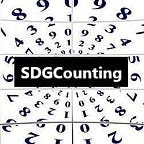Using Data for Better Development
Insights on SDG Data, Artificial Intelligence, and Global Investments from Karthik Muralidharan at TED2024
Despite setbacks from a slowing economy, climate change, global conflict, and the lingering effects of a pandemic, there is still reason to be hopeful about the Sustainable Development Goals, and data may be the key.
This is according to UC San Diego economist Karthik Muralidharan, who recently spoke at TED2024 | The Brave and the Brilliant in a session entitled System Changers. He believes that 10X returns on investment (ROIs) in development projects may be possible by leveraging the data tools and information now available.
In this article we discuss why Dr. Muralidharan is optimistic, what lessons we can learn, and the burgeoning role AI may play in delivering improved global development outcomes.
A Dual Reality: Progress and Challenges
Muralidharan began with a paradox: while key indicators such as child mortality and school enrollment are better today than at any point in human history, many children are still not doing well.
“Though many more children are surviving, large numbers are not thriving”
This is highlighted by the fact that nearly 150 million children are stunted, and 70% of 10-year-olds in low- and middle-income countries cannot read a simple passage.
According to Muralidharan, the most effective way to address our shortcomings, despite our progress, is by leveraging smarter, data-driven spending. Doing this, rather than simply increasing budgets, could significantly enhance global development outcomes.
10X Returns on Investments
The potential of data to improve outcomes is so powerful that even though economists are famously skeptical of “free lunches,” Muralidharan is willing to claim improved global development returns may provide this elusive opportunity.
“The explosion in the availability of data, computing power, and better research methods, including the growing use of randomized controlled trials in social policy, has helped us identify large sets of interventions that have a 10x return on investment”
This, he argued, constitutes a “free lunch” in development economics: we can achieve more by reallocating resources to high-impact interventions identified through rigorous data analysis.
Education in India: A Case Study
Education is a cornerstone of the SDGs, and Muralidharan’s analysis of this sector provides critical insights. While school enrollment has increased, this has not translated into improved learning outcomes. He illustrated this with data from over 6,000 students in India, showing that most students fall significantly behind the curriculum quickly and stay behind.
In practice, children fall behind quickly for a variety of reasons and stay behind. The true academic progress is around half of what is in the curriculum, which means your average eighth-grade kid in public school in India has about a fourth-grade level of understanding of mathematics.
Can AI Provide the Solution?
Muralidharan highlighted the potential of AI-driven tools to address these challenges. Customized learning software like Mindspark, which adapts instruction to individual learning levels, has shown significant promise. In a study in India, students using Mindspark gained a full year of learning in just four months. However, he cautioned that technology alone is not a silver bullet. During the COVID-19 pandemic, providing tablets with Mindspark to students for home use had no impact without adult supervision.
“Technology has the potential to be transformative, but it’s not a silver bullet by itself. If you use the data and the evidence to iterate the solution, you can use technology to transform education at scale.”
What About Low-Tech, High-Impact Solutions?
Not all effective interventions rely on high technology. Muralidharan discussed the success of remedial tutoring programs in India, where high school graduates provided after-school instruction. These programs were both effective and cost-efficient, demonstrating that impactful solutions can be simple and scalable.
The Role of Government and Accountability
In addition to discussing both high-tech and low-tech solutions, a significant portion of Muralidharan’s talk focused on the critical role of government in global development. He observed, unlike the private sector, governments do not face market pressures to optimize efficiency, often resulting in ineffective spending.
Effective governance and accountability are essential for maximizing the impact of public spending. Muralidharan argued that building robust public systems and using data to guide policy decisions are crucial for achieving the SDGs.
Conclusion: Optimism Rooted in Data
In a world facing multiple serious challenges, Muralidharan’s message is one of cautious optimism: There are huge opportunities for increasing effectiveness and efficiency in global development investment if we are able to leverage the information and tools we now have available.
Muralidharan’s insights underscore the critical role of data in not only tracking progress but also driving it. By leveraging AI and machine learning, we can further enhance our ability to identify and scale high-impact interventions, ensuring that we achieve the Global Goals and create a more equitable world for all.
SDGCounting is a program of StartingUpGood and tracks the progress of counting and measuring the success of the SDGs. Follow us on social media:
For the latest on innovative entrepreneurship and social enterprise, check out StartingUpGood on Twitter/X and LinkedIn.
Disclaimer: Generative AI tools such as OpenAI’s GPT and Google’s Gemini were used in the creation of this article to assist with summarization and proof reading.
